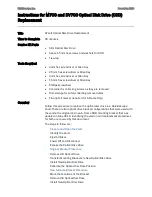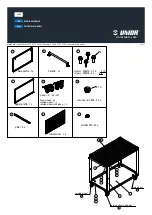
Chapter 4. IBM System Storage DS planning and configuration
115
Follow these guidelines to plan your hot spare coverage properly:
Hot spare disk drives must be of the same media type and interface type as the disk drives
that they are protecting.
Similarly, hard disk drives can only be hot spares for other hard disk drives, not Solid State
Drives (SSDs).
Hot spare disk drives must have capacities equal to or larger than the used capacity on the
disk drives that they are protecting. The DS5000 storage subsystem can use a larger drive
to recover a smaller failed drive to it. It will not use smaller drives to recover a larger failed
drive. If a larger drive is used, the remaining excess capacity is blocked from use.
FDE disk drives provide coverage for both security capable and non-security capable disk
drives. Non-security capable disk drives can provide coverage only for other non-security
capable disk drives.
– For an array that has secured FDE drives, the hot-spare drive should be an unsecured
FDE drive of the same or greater capacity.
– For an array that has FDE drives that are not secured, the hot-spare drive can be either
an unsecured FDE drive or a non-FDE drive.
In a mixed disk environment that includes non-security capable SATA drives,
non-security-capable Fibre Channel drives, and FDE Fibre Channel drives (with security
enabled or not enabled), use at least one type of global hot-spare drive (FDE Fibre Channel
and a SATA drive) at the largest capacity within the array. If a secure-capable FDE Fibre
Channel and SATA hot-spare drive are included, all arrays are protected.
Hot spares locations
Distribute the hot spare drives evenly across the different expansions of your storage
subsystem, but avoid having multiple ones in a single enclosure. Because hot spare drives
are in standby, without traffic or I/O until a drive fails, then you want to maximize the overall
performance of your system by evenly distributing your production drives across the different
expansions. At the same time, this avoids the risk of a single disk drive channel, or expansion
enclosure failure, causing loss of access to all hot spare drives in the storage subsystem.
However, in some configurations, for example, a DS5000 storage subsystem with five
expansions evenly distributed across the four different drive channels to maximize the traffic
to each enclosure, you can choose to maximize performance over availability by having all the
spares defined in the fifth expansion. This way, the channel with two expansions will not be
penalized for excessive traffic, because the spares expansion will not contribute to the traffic
load in that channel.
Important: When assigning disks as hot spares, make sure they have enough storage
capacity. If the failed disk used capacity is larger than the hot spare, reconstruction is not
possible. Ensure that you have at least one of each size or all larger drives configured as
hot spares.
Important: Distribute your spare drives evenly across the different expansion to avoid the
possibility of a general enclosure failure.
Содержание System Storage DS4000
Страница 2: ......
Страница 18: ...xvi IBM Midrange System Storage Hardware Guide...
Страница 40: ...22 IBM Midrange System Storage Hardware Guide...
Страница 302: ...284 IBM Midrange System Storage Hardware Guide...
Страница 344: ...326 IBM Midrange System Storage Hardware Guide...
Страница 372: ...354 IBM Midrange System Storage Hardware Guide Figure 7 25 Drive firmware Incompatible...
Страница 490: ...472 IBM Midrange System Storage Hardware Guide...
Страница 522: ...504 IBM Midrange System Storage Hardware Guide...
Страница 544: ...526 IBM Midrange System Storage Hardware Guide...
Страница 561: ...Index 543 Z zoning 129 130...
Страница 562: ...544 IBM Midrange System Storage Hardware Guide...
Страница 564: ...IBM Midrange System Storage Hardware Guide IBM Midrange System Storage Hardware Guide...
Страница 565: ......
















































